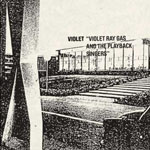
CD, Zeromoon & Sentient Recognition Archive, 2009
www.zeromoon.com/violet
Nurtured on the endless spooling of cassette reels and musique concrète aesthetics, Washington, DC, artist Jeff Surak has in the last decade released an extensive catalogue of solo work under the Violet moniker. Characterized by long drones and grainy, experimental textures (matching its appealing monochrome cover art), “Violet Ray Gas and the Playback Singers” is the latest full-length from this electroacoustic pundit. Here he communicates a dystopian vision grounded in the sordid truths of machine hegemony and steampunk pipe dreams. Utilizing the requisite field recordings, found sounds, CD/tape/vinyl manipulations, etc., Violet presents listeners with an album both disquieting in its peacefulness and jarring in its white noise banality.
The release opens with the comparatively brief “All Records Collapse”, which includes spoken Russian narrative, flat high-pitched tones and muted pulses. However, it is with the extensive (fourteen-minute) second track, “Marionetki”, that Violet really flexes some muscles, submitting to its audience multiple, abrupt phase shifts ranging from oscillating machine drones to empty space, practically inaudible ambient minimalism to vaulted cathedral atmospheres and, finally, a shocking cut to straight wall-of-noise delivery. Disjointed as such, not to mention lengthy, it is questionable whether this collection of passages succeeds. Another debatable, yet undoubtedly well-executed, evolution occurs in “Violet Ray Gas”, which, in the space of thirteen minutes, degrades detuned classical strings (violins, etc.) in layers of escalating post-melodic complexity until reaching a bristling climax of staccato with rich, drone-like strokes beneath.
But perhaps this illogical streak is what makes “Violet Ray Gas…” interesting. It tends to cultivate a what-happens-next curiosity, and rewards those patient listeners with more flowing compositions, such as desolate “Plague Numbers”, full of peaceful, airy drones, and “Interior Ghosts”, marked by windswept, whistling sweeps that calm to an eerie, floating ambience later in the track. Perhaps even better is the organic twist offered by “Snakehead Lapping”, wherein water sounds (gurgling, plopping) eventually give way to grainy orchestral billowing peppered with static crackling. It is no coincidence that the piece takes its name from a highly invasive Asian fish variety discovered to have established itself in the DC/Baltimore watershed several years ago. Unfortunately, for the most part “Violet Ray Gas…” is not so much mentally invasive as vaguely irritating, lacking the essential cohesion necessary in an experimental/drone record and likely far more interesting in terms of creative process than actual listenability.
[5/10]
— Dutton Hauhart
